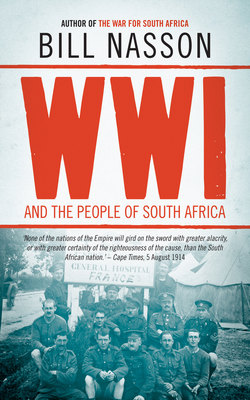Читать книгу World War One and the People of South Africa - Bill Nasson - Страница 5
На сайте Литреса книга снята с продажи.
ОглавлениеPreface
Today, as we reach the centenary of the catastrophic world war that was once called the war to end all wars, we now have a greater appreciation of it as a huge global conflict, indeed, as a turning point in modern history. The industrial bloodbath brought about by the nations of the European imperial world consumed not only Europe itself. For, while the peace that came eventually depended on the outcome of the conflict in Europe and on its Western Front, regions very far away were sucked into a titanic struggle, and were affected in deep and complicated ways.
In what was then the Union of South Africa, readers of the souvenir booklet of Cape Town’s official peace celebrations of August 1919 were reminded of how fortunate they had been, as their ‘security was never disturbed by an enemy ship. No Zeppelins or aeroplanes have bombed our streets. Not a single citizen has had cause to fear for his personal safety.’ Nevertheless, as The Peace Celebrations – Cape Town 1919 concluded, even ‘here in this bright and sunny land of ours’, in which ‘we have been spared the horrors of the scourge’, South Africa’s people had been drawn into ‘a hundred activities called into being by the War’ and had ‘all learned much’.
This book is an attempt to provide a perspective on that distinctive wartime experience, for this was especially a country in which people did not respond to the crisis of 1914-1918 in simple terms, nor in tidy ways. While a relatively small number of men volunteered to fight beyond the country’s borders, they left behind a place in which life consisted of a messy, at times painful, combination of conflicting loyalties, doubts, hostilities, hatreds, strains and uncertainties. I hope that a sense of that atmosphere might convey to the reader some appreciation of the complexities and varying challenges of the war for the people of South Africa, in what was truly a global war of many peoples.
In explaining what kind of book this is – a short, illustrated account of how the inhabitants of South Africa responded to the war, and lived as a population at war – I should at the same time say what this book is not. It is not about how South Africa’s war has come to be commemorated or remembered nationally. Nor, although it is shaped by the realities of why and where South Africa fought, is this a general military history, concerned with the particulars of campaigns, battles and the individual experiences of fighting in Africa and overseas. That said, many of the illustrations that follow are intended to document something of that sharp end – what the great American poet Walt Whitman called, in 1863 (in the middle of his country’s Civil War agony), the ‘red life-blood oozing’. In its own way, photography captures vividly the essential character of this war, through images that are a peculiar assortment of the strange and the familiar, the repellent and the fascinating.
In the course of producing any book, one always incurs numerous debts. In this instance, I have a fair share, to say nothing of a lot more besides. Among the many to whom I owe an assortment of war reparations over the years, I should like to thank especially Albert Grundlingh, Mark Connelly, Alan Kramer, John Horne, Robert Gerwarth, Jay Winter, Ian van der Waag, Jeffrey Grey, Natie Greeff, Mac Bisset and Jacques de Vries. I would also like to record my gratitude to other treasured friends and acquaintances who have taken a kind and encouraging personal interest in the progress (or otherwise) of my World War One scribblings, particularly Vivian Bickford-Smith, David Johnson, Jenny Hobbs, Helen Binckes, Lydia du Plessis, Tanya Wilson, Gareth Smit, Hugh Corder, Lauren van Vuuren, Alex Matthews, Keren Ben-Zeev, Wilhelm Snyman, Claire Keeton, Tim Couzens and Roger Goodwin. My warm thanks, too, to the many stimulating students of my War and Society courses, previously at the University of Cape Town and, more recently, at the University of Stellenbosch, for helping me to maintain a long campaign – to what end is for them to judge.
Once again, I cannot praise too highly my perfectionist, perceptive and generous publishing editor, Annie Olivier, for the extraordinary amount that she has contributed to the production of this book. I am also grateful to others at my publisher, Tafelberg, for expert assistance and constant encouragement, not least Surita Joubert, whose promoting of books is almost surpassed by her promoting of fine wine.
I am also most grateful to the Military Museum of the Castle of Good Hope in Cape Town for permission to have rare items from its collections photographed and displayed in these pages.
Some of the material used here appeared in a different form in Springboks on the Somme (Penguin Books, 2007). Here, too, acknowledgement is due.
Finally, how do I thank Ann and Leah, who continue to live cheerfully with this sort of human activity?
Naturally, none of the above bears any responsibility for the opinions and arguments of this volume, nor for its errors or shortcomings. This applies most of all to the pair of constant companions to whom this work is dedicated. Stubbornly non-literate, at most they might bring themselves to give it a bored sniff.
BILL NASSON,
Professor of History at the University of Stellenbosch
